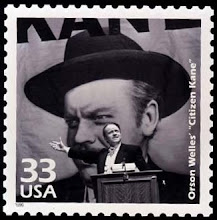Maximum Card: a postcard with an enlarged picture of a commemorative postage stamp, with the stamp itself postmarked on the picture, usually the first day of issue.
I ran into this term a couple years ago, but it’s never been clear to me how pervasive it was (not to mention its assorted variations) in the philatelic community. It's always struck me as a niche that’s often relegated to an afterthought. Doing a little digging, though, I did unearth this.
In other words…Zzzzzzzzzzzzzzzzz. Essentially, According-to-Hoyle restrictions on what does and doesn’t constitute a maximum card bore me. Here’s one I created that doesn’t “qualify” by FIP standards for a variety of reasons, but which I like—plus, it also brings up some additional attributes of my collection that haven’t been discussed yet.

First of all, although all my previous blog posts have dealt with postcards with various cinematic themes, this is actually the first stamp I’ve posted about that is film-related itself. This was part of the 10-stamp American Filmmaking series issued back in 2003, with an unexpected bonus that the illustrated postmark used the Academy Award statuette in the design. Dances with Wolves (Costner, 1990), of course, did win 7 Oscars back—including Best Sound (and most famously beating out Martin Scorsese’s GoodFellas for Picture and Director). Needless to say, I’ll eventually post examples of all 10 of the stamps from that series (which include Editing, Cinematography, Art Direction, and others).
Another distinctive element of this card is that it actually incorporates older stamps with a more contemporary issue and postmark (this is different from the multiple-FDCs I posted about earlier). In this particular case, the additional stamps are:
Crazy Horse (1982 – Scott #1855)
Red Cloud (1987 – Scott #2175)
Sitting Bull (1989 – Scott #2183)
The Scott # refers to the Scott Publishing Company and its specialized catalog, which is the philatelist’s bible in researching and referencing every postage stamp ever issued, both in the US and every other country on earth. The international catalog is a multi-volume series that is updated annually, but I just own a copy of the US catalog exactly for situations like this: sometimes, a card presents itself that invites the use of additional, previously-released stamps that dovetail nicely with the subject matter of the card I’m using.
Needless to say, I usually don't have these stamps just lying around, so they do constitute an additional investment, but for older stamps, they're usually pretty reasonably priced (for example, it would cost me $1.90 today to buy the 3 Native American stamps I just listed). That's the main reason I attend stamp shows like Westpex (only two months away!)

Here's another component to my collection--I'll also use the back of the postcards, not just the front, to assemble additional FDCs which may not (for space or aesthetic reasons) be suitable to use on the face. You see that on the back of this card, I also used previously issued stamps with a newer FDC—in this case, one from the 40-part Wonders of America series issued in 2006. The additional stamps are:
Wildlife - Buffalo (1969 – Scott #1392)
Buffalo (2000 – Scott #3468)
I really like using older stamps (in this case, even one issued before I was born), not only because of the variety of style and colors they add on an aesthetic level, but also because I think it provides interesting connective tissue with the past. US stamps in particular represent America’s political and cultural history, and I like incorporating that sense of history into the card assemblies I create. And interestingly enough, the older the stamp, the cheaper it often is to procure. Because the '69 stamp had an original face value of 6 cents, it can increase in value over 600% and still cost less than the 2000 stamp (obviously, once you start hitting the turn-of-the-previous-century, this general rule flies out the window).

Since WonderCon was this past weekend, I thought I would include an FDC from one of the DC Comic issues, since I've already included a few of the Marvel stamps that were released a year later. I haven't collected comics in over 20 years, but these shows also feature lots of movie memoribilia for sale, so it can be a good place to find some movie postcards, if the right vendor shows up. I may even have gotten this card at a previous convention. I have to say I have never actually seen Batwoman (Cardona, 1968), but I can't imagine it can be anywhere as cool as the one-sheet makes it appear.
Lots of film wrap-up catch-ups await, so keep coming back! B^)




